Business Law: Michelin Award Restaurant Case Study - Legal Analysis
VerifiedAdded on 2022/08/19
|6
|1284
|22
Case Study
AI Summary
This case study delves into several business law issues. The first issue examines potential claims of a Maître d’ against a restaurant, focusing on employment contract breaches and intellectual property rights related to an app developed during employment. It analyzes scenarios where the employment agreement is 'work for hire' versus jointly owned, and the timing of the app's creation. The second issue assesses whether Sally breached a contract by accepting goods from a new supplier with altered payment terms. The analysis applies contract law principles, determining that Sally did breach the contract and is liable for damages. The document concludes with relevant case law and references, offering a comprehensive overview of the legal considerations.
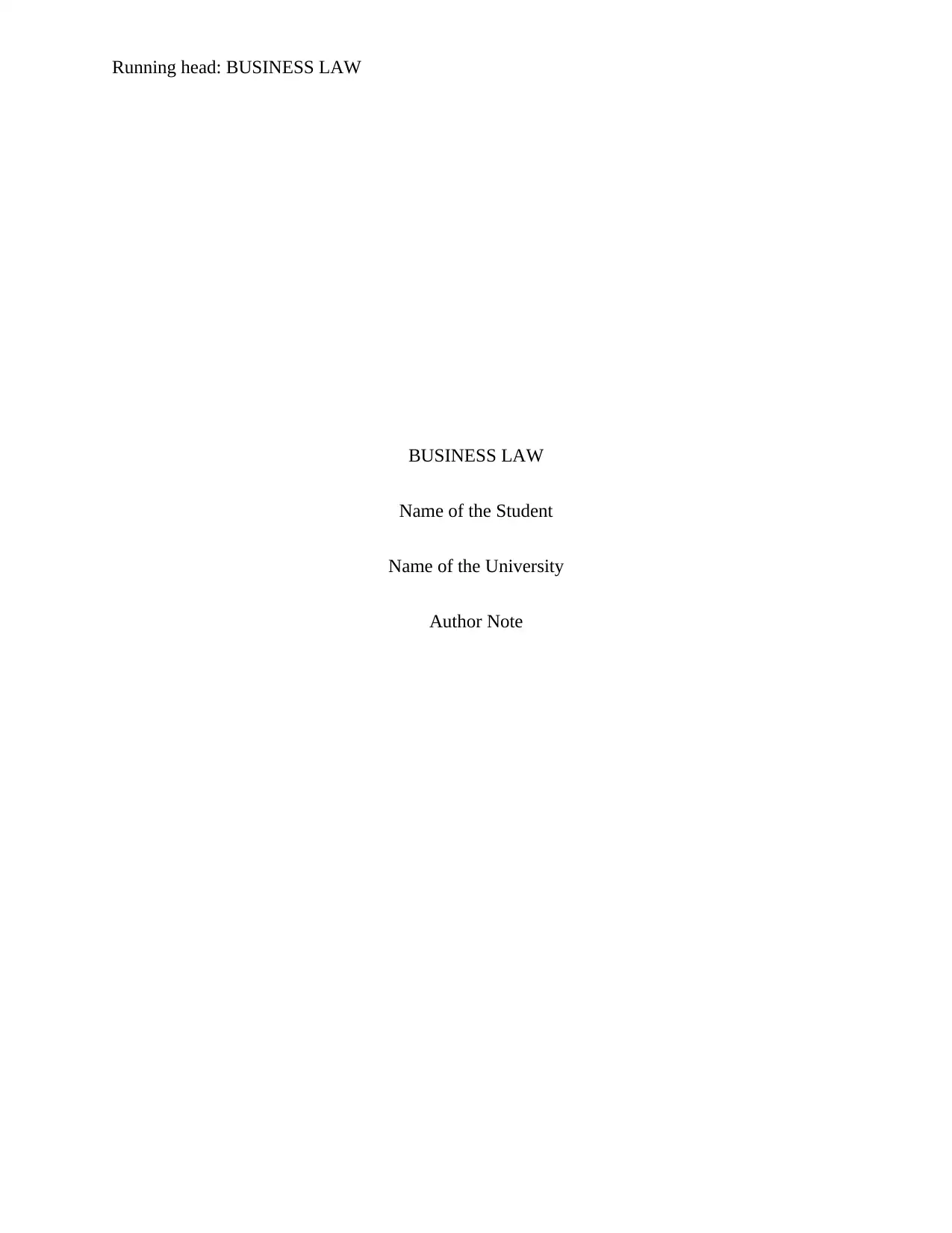
Running head: BUSINESS LAW
BUSINESS LAW
Name of the Student
Name of the University
Author Note
BUSINESS LAW
Name of the Student
Name of the University
Author Note
Paraphrase This Document
Need a fresh take? Get an instant paraphrase of this document with our AI Paraphraser
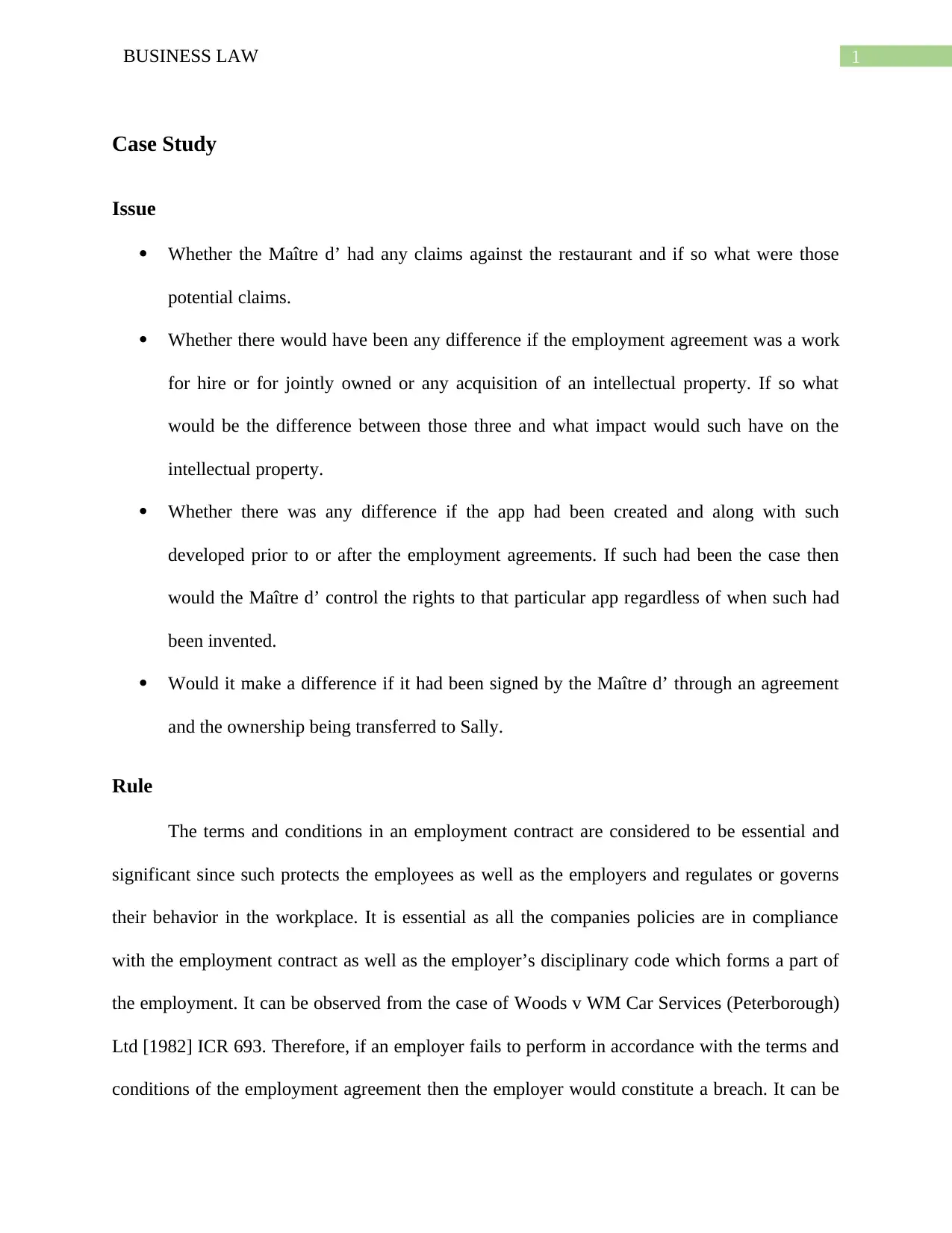
1BUSINESS LAW
Case Study
Issue
Whether the Maître d’ had any claims against the restaurant and if so what were those
potential claims.
Whether there would have been any difference if the employment agreement was a work
for hire or for jointly owned or any acquisition of an intellectual property. If so what
would be the difference between those three and what impact would such have on the
intellectual property.
Whether there was any difference if the app had been created and along with such
developed prior to or after the employment agreements. If such had been the case then
would the Maître d’ control the rights to that particular app regardless of when such had
been invented.
Would it make a difference if it had been signed by the Maître d’ through an agreement
and the ownership being transferred to Sally.
Rule
The terms and conditions in an employment contract are considered to be essential and
significant since such protects the employees as well as the employers and regulates or governs
their behavior in the workplace. It is essential as all the companies policies are in compliance
with the employment contract as well as the employer’s disciplinary code which forms a part of
the employment. It can be observed from the case of Woods v WM Car Services (Peterborough)
Ltd [1982] ICR 693. Therefore, if an employer fails to perform in accordance with the terms and
conditions of the employment agreement then the employer would constitute a breach. It can be
Case Study
Issue
Whether the Maître d’ had any claims against the restaurant and if so what were those
potential claims.
Whether there would have been any difference if the employment agreement was a work
for hire or for jointly owned or any acquisition of an intellectual property. If so what
would be the difference between those three and what impact would such have on the
intellectual property.
Whether there was any difference if the app had been created and along with such
developed prior to or after the employment agreements. If such had been the case then
would the Maître d’ control the rights to that particular app regardless of when such had
been invented.
Would it make a difference if it had been signed by the Maître d’ through an agreement
and the ownership being transferred to Sally.
Rule
The terms and conditions in an employment contract are considered to be essential and
significant since such protects the employees as well as the employers and regulates or governs
their behavior in the workplace. It is essential as all the companies policies are in compliance
with the employment contract as well as the employer’s disciplinary code which forms a part of
the employment. It can be observed from the case of Woods v WM Car Services (Peterborough)
Ltd [1982] ICR 693. Therefore, if an employer fails to perform in accordance with the terms and
conditions of the employment agreement then the employer would constitute a breach. It can be
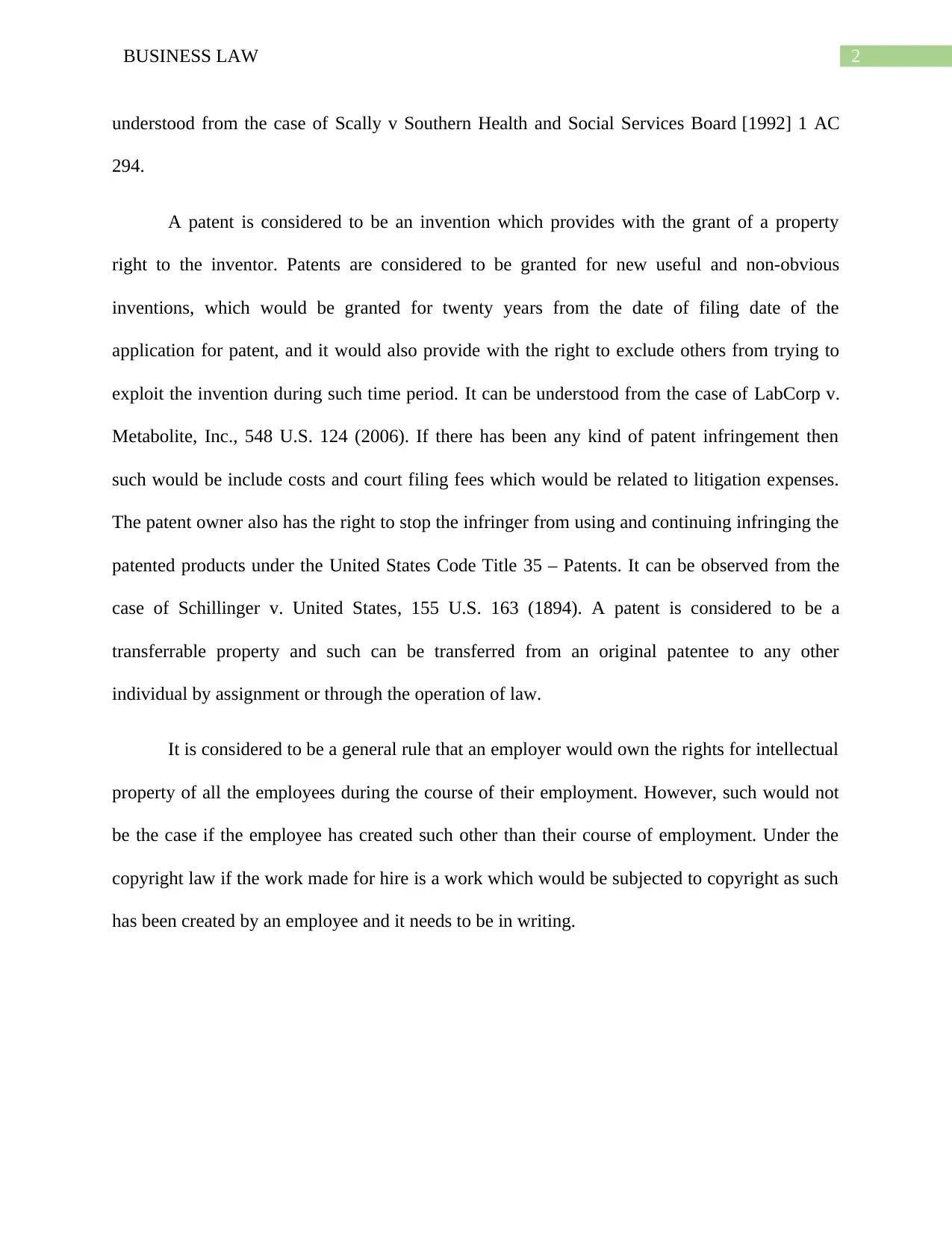
2BUSINESS LAW
understood from the case of Scally v Southern Health and Social Services Board [1992] 1 AC
294.
A patent is considered to be an invention which provides with the grant of a property
right to the inventor. Patents are considered to be granted for new useful and non-obvious
inventions, which would be granted for twenty years from the date of filing date of the
application for patent, and it would also provide with the right to exclude others from trying to
exploit the invention during such time period. It can be understood from the case of LabCorp v.
Metabolite, Inc., 548 U.S. 124 (2006). If there has been any kind of patent infringement then
such would be include costs and court filing fees which would be related to litigation expenses.
The patent owner also has the right to stop the infringer from using and continuing infringing the
patented products under the United States Code Title 35 – Patents. It can be observed from the
case of Schillinger v. United States, 155 U.S. 163 (1894). A patent is considered to be a
transferrable property and such can be transferred from an original patentee to any other
individual by assignment or through the operation of law.
It is considered to be a general rule that an employer would own the rights for intellectual
property of all the employees during the course of their employment. However, such would not
be the case if the employee has created such other than their course of employment. Under the
copyright law if the work made for hire is a work which would be subjected to copyright as such
has been created by an employee and it needs to be in writing.
understood from the case of Scally v Southern Health and Social Services Board [1992] 1 AC
294.
A patent is considered to be an invention which provides with the grant of a property
right to the inventor. Patents are considered to be granted for new useful and non-obvious
inventions, which would be granted for twenty years from the date of filing date of the
application for patent, and it would also provide with the right to exclude others from trying to
exploit the invention during such time period. It can be understood from the case of LabCorp v.
Metabolite, Inc., 548 U.S. 124 (2006). If there has been any kind of patent infringement then
such would be include costs and court filing fees which would be related to litigation expenses.
The patent owner also has the right to stop the infringer from using and continuing infringing the
patented products under the United States Code Title 35 – Patents. It can be observed from the
case of Schillinger v. United States, 155 U.S. 163 (1894). A patent is considered to be a
transferrable property and such can be transferred from an original patentee to any other
individual by assignment or through the operation of law.
It is considered to be a general rule that an employer would own the rights for intellectual
property of all the employees during the course of their employment. However, such would not
be the case if the employee has created such other than their course of employment. Under the
copyright law if the work made for hire is a work which would be subjected to copyright as such
has been created by an employee and it needs to be in writing.
⊘ This is a preview!⊘
Do you want full access?
Subscribe today to unlock all pages.

Trusted by 1+ million students worldwide
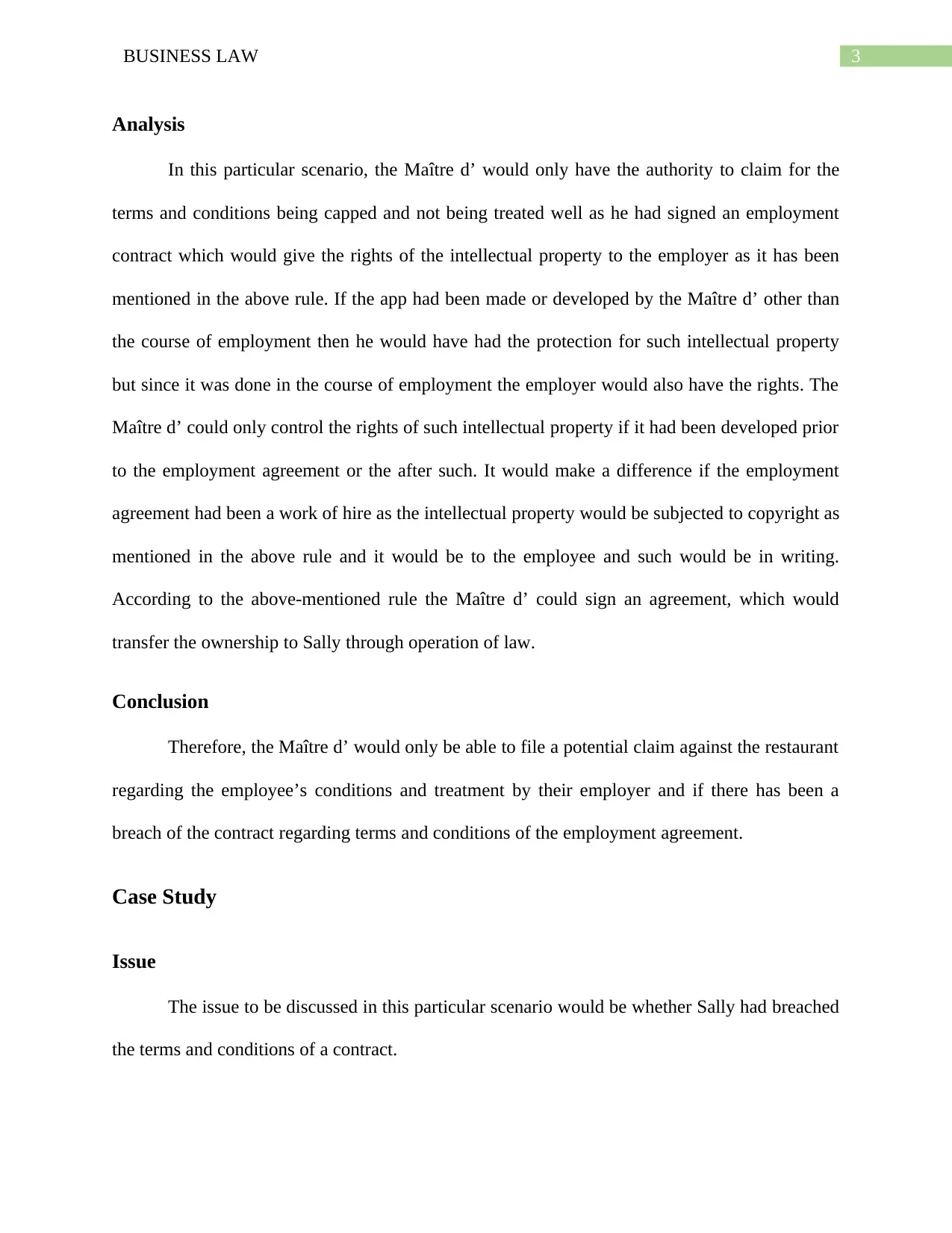
3BUSINESS LAW
Analysis
In this particular scenario, the Maître d’ would only have the authority to claim for the
terms and conditions being capped and not being treated well as he had signed an employment
contract which would give the rights of the intellectual property to the employer as it has been
mentioned in the above rule. If the app had been made or developed by the Maître d’ other than
the course of employment then he would have had the protection for such intellectual property
but since it was done in the course of employment the employer would also have the rights. The
Maître d’ could only control the rights of such intellectual property if it had been developed prior
to the employment agreement or the after such. It would make a difference if the employment
agreement had been a work of hire as the intellectual property would be subjected to copyright as
mentioned in the above rule and it would be to the employee and such would be in writing.
According to the above-mentioned rule the Maître d’ could sign an agreement, which would
transfer the ownership to Sally through operation of law.
Conclusion
Therefore, the Maître d’ would only be able to file a potential claim against the restaurant
regarding the employee’s conditions and treatment by their employer and if there has been a
breach of the contract regarding terms and conditions of the employment agreement.
Case Study
Issue
The issue to be discussed in this particular scenario would be whether Sally had breached
the terms and conditions of a contract.
Analysis
In this particular scenario, the Maître d’ would only have the authority to claim for the
terms and conditions being capped and not being treated well as he had signed an employment
contract which would give the rights of the intellectual property to the employer as it has been
mentioned in the above rule. If the app had been made or developed by the Maître d’ other than
the course of employment then he would have had the protection for such intellectual property
but since it was done in the course of employment the employer would also have the rights. The
Maître d’ could only control the rights of such intellectual property if it had been developed prior
to the employment agreement or the after such. It would make a difference if the employment
agreement had been a work of hire as the intellectual property would be subjected to copyright as
mentioned in the above rule and it would be to the employee and such would be in writing.
According to the above-mentioned rule the Maître d’ could sign an agreement, which would
transfer the ownership to Sally through operation of law.
Conclusion
Therefore, the Maître d’ would only be able to file a potential claim against the restaurant
regarding the employee’s conditions and treatment by their employer and if there has been a
breach of the contract regarding terms and conditions of the employment agreement.
Case Study
Issue
The issue to be discussed in this particular scenario would be whether Sally had breached
the terms and conditions of a contract.
Paraphrase This Document
Need a fresh take? Get an instant paraphrase of this document with our AI Paraphraser
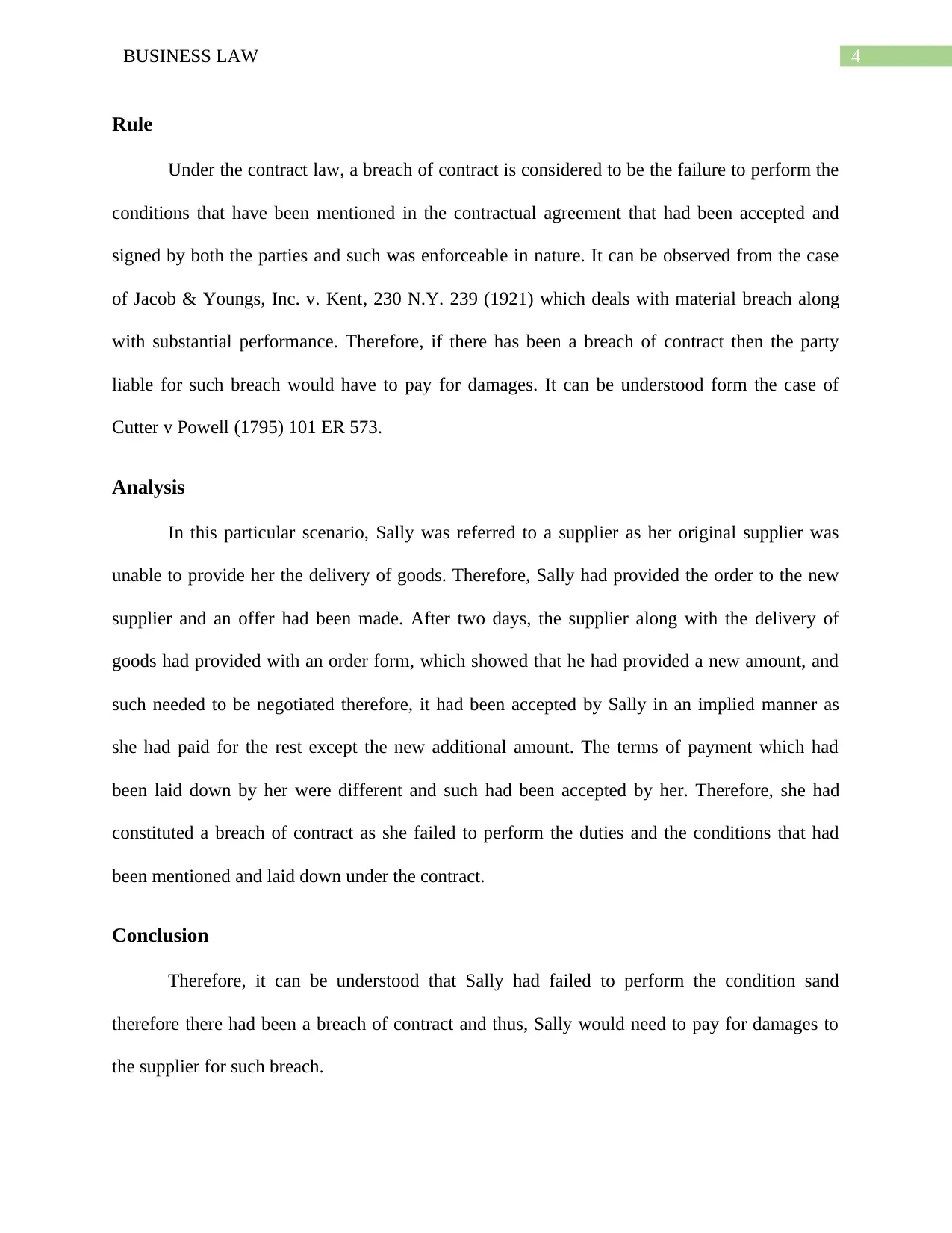
4BUSINESS LAW
Rule
Under the contract law, a breach of contract is considered to be the failure to perform the
conditions that have been mentioned in the contractual agreement that had been accepted and
signed by both the parties and such was enforceable in nature. It can be observed from the case
of Jacob & Youngs, Inc. v. Kent, 230 N.Y. 239 (1921) which deals with material breach along
with substantial performance. Therefore, if there has been a breach of contract then the party
liable for such breach would have to pay for damages. It can be understood form the case of
Cutter v Powell (1795) 101 ER 573.
Analysis
In this particular scenario, Sally was referred to a supplier as her original supplier was
unable to provide her the delivery of goods. Therefore, Sally had provided the order to the new
supplier and an offer had been made. After two days, the supplier along with the delivery of
goods had provided with an order form, which showed that he had provided a new amount, and
such needed to be negotiated therefore, it had been accepted by Sally in an implied manner as
she had paid for the rest except the new additional amount. The terms of payment which had
been laid down by her were different and such had been accepted by her. Therefore, she had
constituted a breach of contract as she failed to perform the duties and the conditions that had
been mentioned and laid down under the contract.
Conclusion
Therefore, it can be understood that Sally had failed to perform the condition sand
therefore there had been a breach of contract and thus, Sally would need to pay for damages to
the supplier for such breach.
Rule
Under the contract law, a breach of contract is considered to be the failure to perform the
conditions that have been mentioned in the contractual agreement that had been accepted and
signed by both the parties and such was enforceable in nature. It can be observed from the case
of Jacob & Youngs, Inc. v. Kent, 230 N.Y. 239 (1921) which deals with material breach along
with substantial performance. Therefore, if there has been a breach of contract then the party
liable for such breach would have to pay for damages. It can be understood form the case of
Cutter v Powell (1795) 101 ER 573.
Analysis
In this particular scenario, Sally was referred to a supplier as her original supplier was
unable to provide her the delivery of goods. Therefore, Sally had provided the order to the new
supplier and an offer had been made. After two days, the supplier along with the delivery of
goods had provided with an order form, which showed that he had provided a new amount, and
such needed to be negotiated therefore, it had been accepted by Sally in an implied manner as
she had paid for the rest except the new additional amount. The terms of payment which had
been laid down by her were different and such had been accepted by her. Therefore, she had
constituted a breach of contract as she failed to perform the duties and the conditions that had
been mentioned and laid down under the contract.
Conclusion
Therefore, it can be understood that Sally had failed to perform the condition sand
therefore there had been a breach of contract and thus, Sally would need to pay for damages to
the supplier for such breach.
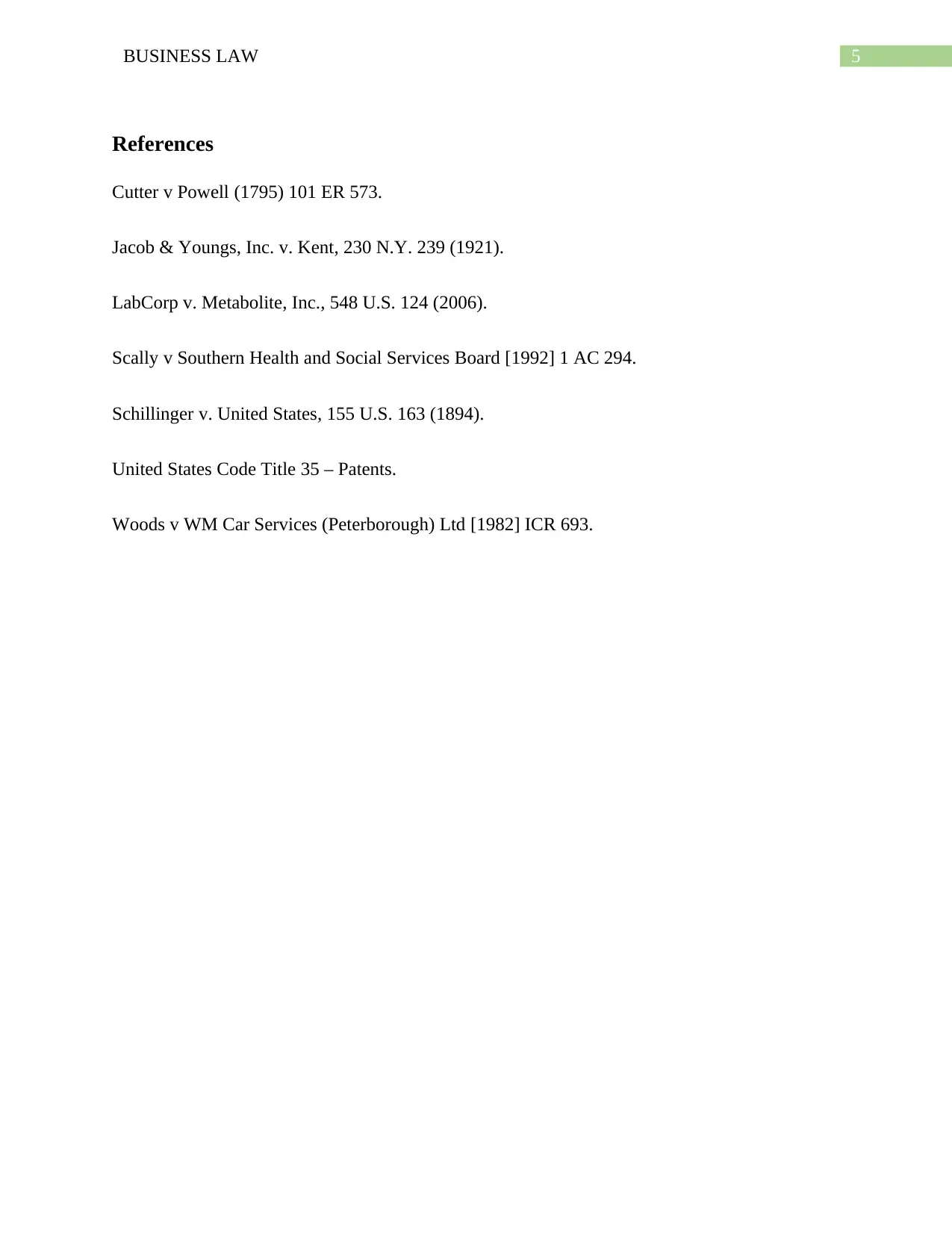
5BUSINESS LAW
References
Cutter v Powell (1795) 101 ER 573.
Jacob & Youngs, Inc. v. Kent, 230 N.Y. 239 (1921).
LabCorp v. Metabolite, Inc., 548 U.S. 124 (2006).
Scally v Southern Health and Social Services Board [1992] 1 AC 294.
Schillinger v. United States, 155 U.S. 163 (1894).
United States Code Title 35 – Patents.
Woods v WM Car Services (Peterborough) Ltd [1982] ICR 693.
References
Cutter v Powell (1795) 101 ER 573.
Jacob & Youngs, Inc. v. Kent, 230 N.Y. 239 (1921).
LabCorp v. Metabolite, Inc., 548 U.S. 124 (2006).
Scally v Southern Health and Social Services Board [1992] 1 AC 294.
Schillinger v. United States, 155 U.S. 163 (1894).
United States Code Title 35 – Patents.
Woods v WM Car Services (Peterborough) Ltd [1982] ICR 693.
⊘ This is a preview!⊘
Do you want full access?
Subscribe today to unlock all pages.

Trusted by 1+ million students worldwide
1 out of 6
Related Documents
Your All-in-One AI-Powered Toolkit for Academic Success.
+13062052269
info@desklib.com
Available 24*7 on WhatsApp / Email
![[object Object]](/_next/static/media/star-bottom.7253800d.svg)
Unlock your academic potential
Copyright © 2020–2025 A2Z Services. All Rights Reserved. Developed and managed by ZUCOL.





